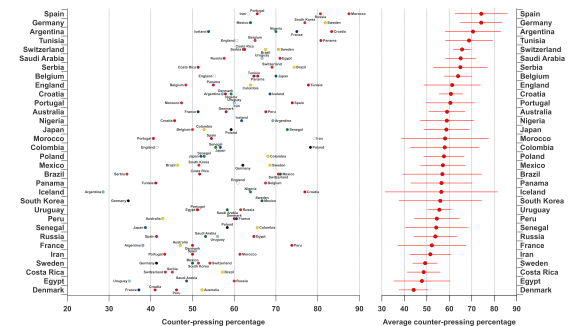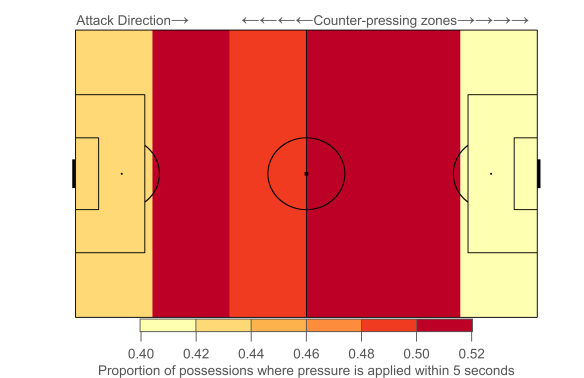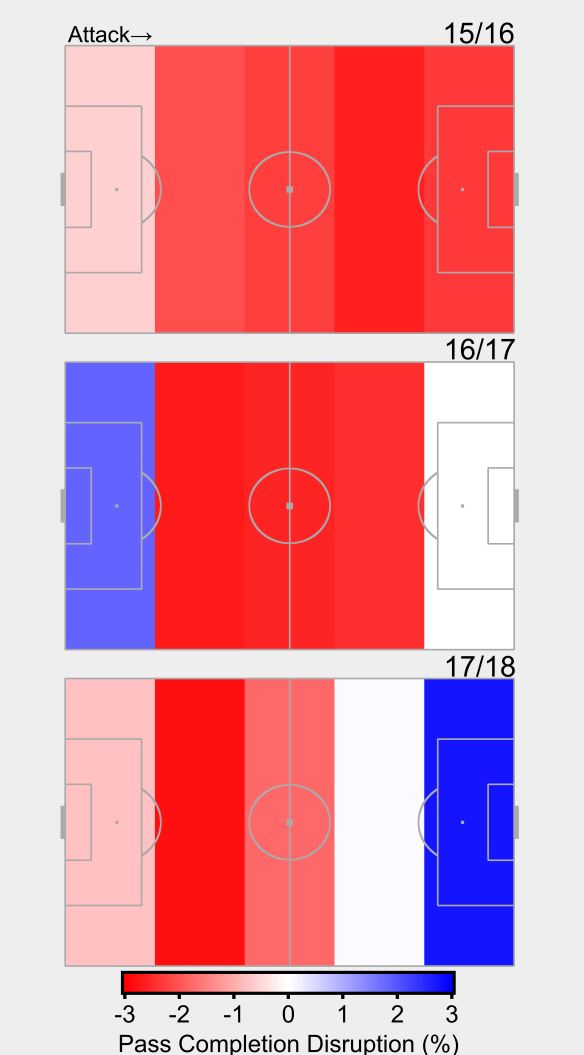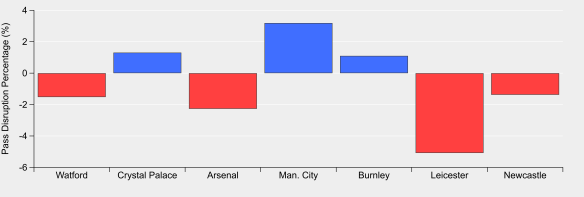Originally published on StatsBomb.
One of the tactical questions heading into the World Cup was whether the modern popularity of pressing at club level would be replicated on the international stage. The best pressing teams are a meld of intelligent positioning and trigger movements, honed during hours on the training pitch, requiring intense and sustained athletic performance.
Such luxuries are not afforded to international teams, who have far less training time to drill such tactics, coupled with many players arriving at the tournament after long club seasons. A heatwave encompassing much of Europe, including many of the west Russian venues, presents another potential barrier to intense pressing at the tournament.
Gegenpressing or counter-pressing is one form of pressing, where a team presses the opposition immediately after losing possession, with the initial aim being to disrupt the opponent’s transition phase and potential counter-attack. Across the English Premier League last season, 46% of open-play possessions were pressed within 5 seconds, with the trio of Spurs, Liverpool and Manchester City leading the league with a counter-pressing fraction of close to 60%. At the other end of the scale was Stoke City and West Brom at around 35%.
Perhaps surprisingly, the counter-pressing rate at the World Cup through the group stage and last-sixteen stands at 59%. There are a number of contextual factors to these figures that partially explain this difference. Note the absolute figures below are per game per team.
Firstly there have been slightly fewer open-play possessions available to counter-press at the World Cup (33) than in the EPL (35); fewer open-play possessions potentially means that teams are able to maintain a higher intensity, which would shift the observed counter-pressing fractions. This is borne out in the average number of counter-pressed possessions, which stands at 19 possessions in the World Cup compared to 16 possessions in the EPL.
Secondly there is a significant stylistic contrast between the EPL and World Cup in terms of passing, with 66 long balls per game in the former and 59 per game in the latter. Conversely, short passes are greater (398 per game) at the World Cup than in the past EPL season (392). The greater propensity towards long balls in the EPL, especially early on in a possession, cuts down on opportunities to counter-press, while a lower number of shorter passes will act in a similar manner.
The third factor is the differing priorities and incentives of a World Cup group stage and a 38-game season. The figure below illustrates the importance of considering the small sample size at play in the World Cup and how a team’s approach will vary from game-to-game. Each team is ranked according to their average counter-pressing percentage, with their individual matches shown to illustrate the variation across the tournament. This variation is further summarized in the right-hand figure, where the standard deviation across their matches is shown as the horizontal lines around each data point (broader lines mean a greater standard deviation and thus more variation).

Iceland are perhaps the best example of how a group stage spanning three matches shapes tactical considerations and can lead to misleading averages – in their first match against Argentina, they registered the lowest counter-pressing percentage of the tournament as they were happy to get players behind the ball and concentrate on frustrating their opponent’s efforts in the final third. A draw against the perceived giant of the group was a good result on their World Cup debut but subsequent matches would require them to force the issue more in search of a win to place them in a good position to advance; their counter-pressing percentage increased in their subsequent matches culminating in a very high counter-pressing rate against Croatia with a win needed for qualification from the group stage.
Contrast this with a team in the EPL that is uninclined to counter-press, such as West Brom, when playing against more favoured opponents – three draws or perhaps a narrow fortuitous win would often be a more than satisfactory outcome, so sitting deep and frustrating the opposition is a sensible strategy. Such considerations apply at the other end of the scale also e.g. taking a small sample of matches against a minnow sitting deep in their own half from Spurs’ season when chasing a win would yield a selection of matches where they aggressively counter-pressed their opponent. This latter example likely explains the very high counter-pressing rate by the likes of Germany, Spain and Argentina as they found themselves in close matches where they needed to push for a win.
This isn’t to say that the tactical approach of all teams at the World Cup is dictated more by game-state and qualification permutations – of the teams remaining Sweden, Uruguay, Croatia and Belgium have been quite consistent across the tournament and are perhaps more likely to employ their preferred counter-pressing intensity in their remaining matches. On the other side of the coin, Brazil, France and England have been more variable with Russia sat in the middle.
Pressing outcomes
In terms of evaluating successful counter-pressing, the gap between the EPL and World Cup is less obvious – 17% of counter-pressing possessions have seen possession won or disrupted within 5 seconds in the World Cup, which is only 1% greater than in the EPL. In both the EPL and World Cup, 10% of counter-pressing possessions have ended with a shot for the team being pressed, which results in an increased absolute rate (1.9 shots per game) in the World Cup compared to the EPL (1.6 per game).
In the EPL, the most aggressive counter-pressing teams tend to also routinely win possession back and concede fewer shots during this phase (Manchester City top the rankings in both categories, with Liverpool not too far behind and Spurs performing at an above average level). Such figures are likely noisier during the World Cup given the small sample size with the trend being similar albeit less strong, with Spain and Argentina performing well in terms of disrupting possession, while being closer to average in terms of conceding shots from counter-pressing possessions.
Many words have been and will continue to be expounded on Germany’s woes at this tournament, but their figures here merit a mention before turning to teams still in the World Cup. They were below average in terms of regaining possession, with a particularly woeful and damaging performance against Mexico. Toni Kroos was the thankless leader of Germany’s counter-press with Mats Hummels and Jérôme Boateng being the next most frequent counter-pressers, which seems shall we say sub-optimal and flies in the face of how other counter-pressing teams profile. Furthermore, 15% of the possessions they counter-pressed ended with their opponent taking a shot, tied for fourth-worst in the tournament. They were also tied for fourth-worst in terms of the number of shots conceded from counter-pressing possessions. Such figures are likely flattering given some of the counter-attacking opportunities wasted by Mexico and South Korea. Vulnerability isn’t a word usually associated with the German national team but that is what they were – yes, they were somewhat unfortunate to score only two goals while finishing bottom of their group but their struggles in defensive transition could have been even more disastrous against better opposition in the knock-out stages. Winning the World Cup is obviously Brazil’s priority but if they were ever going to avenge the 7-1 loss in 2014, then a last-16 clash against this German team would have been their chance.
Quarter-final notes
Uruguay vs France: neither team has been committed to counter-pressing during the tournament so far. When Uruguay have pressed, they haven’t typically regained possession quickly but they have been excellent at slowing down attacks and preventing shots. France have matched them in terms of shot-suppression, which suggests that the decisive moments will come from other angles.
Brazil vs Belgium: Brazil have sought to counter-press their opponents in their most crucial and more-even matches (vs Switzerland and Mexico), so may well aim for a similar strategy against Belgium. Discounting Belgium’s encounter with England (sorry Adnan) suggests they will also seek to put pressure on Brazil during transitions, which indicates the match will be keenly contested when possession is lost. Both teams looked somewhat vulnerable to counter-attacks during their round-of-16 matches and with each of them containing some of the best counter-attacking passers and finishers around, shutting-down or exploiting such opportunities could be key.
Sweden vs England: Sweden sit at the low end of the scale in terms of counter-pressing and have applied such tactics consistently across the tournament. Given their success across qualifying and at this tournament, we shouldn’t expect a deviation from this at the quarter-final stage. England employed an aggressive counter-press against Tunisia in their opener, followed by a drop off against Panama after running up an early lead, while the Belgium game is best forgotten (sorry Adnan). Their match against Colombia saw a return to more of a counter-pressing style, although not at the same level as against Tunisia. In summary, England have been more aggressive during transitions when they’ve had the most riding on their matches and have dominated possession, so expect them to utilize such tactics against Sweden.
Russia vs Croatia: the hosts have generally employed a less aggressive counter-press than their peers, with their lowest rate coming against Spain in the round-of-16. It will be interesting to see if they alter their approach against another technically gifted side. Croatia have counter-pressed at an average rate and at a quite consistent level, so it will be intriguing to see if they contest turn-overs or invite Russia onto them more with the intention of drawing them out of their defensive third.
Pressing has been a perhaps surprising feature of this World Cup and contributed to the narratives around several teams, whether they be success stories or futile failures. Come the 15th of July, we’ll see how much of a role it has played in the denouement of this wonderful World Cup.



